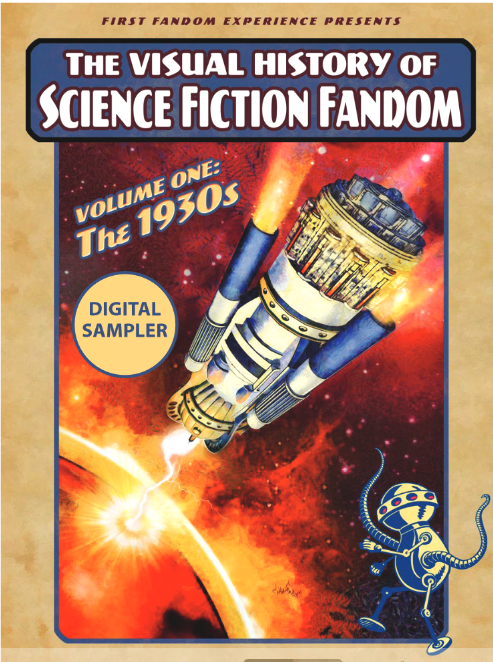One of my earliest memories is of the massive science fiction laden bookcase in my childhood home. I read John W. Campbell, Isaac Asimov, A. E. van Vogt, Ray Bradbury, Larry Niven and other classic sci-fi authors before I was in middle school. That’s understandable given that I’m named for a character in a Robert Heinlein novel. This means I’m unusually familiar with both the art and stories of Golden Age sci-fi. This is why I chose to read and review “The Visual History of Science Fiction Fandom: Part 1”. Part 1 is devoted to the 1930s and came out in hardback in February, 2020.
Why Does Golden Age Science Fiction Matter?
To quote Carl Sagan, these are the stories that inspired the people who put man on the Moon. It was an optimistic time, and we may want to recapture that spirit. (I’ve written elsewhere how the dearth of optimistic science fiction is probably contributing to the difficulty in getting kids interested in STEM.)
Furthermore, these are the stories that led to popular works having an impact today. For example, Asimov’s “Foundation” series is being turned into a TV show. The first stories of the “Robots” series came out in the 1930s.
Golden Age science fiction is more than “swords and sorcery on Mars” or pulpy laser gun fights. For example, it is a 1940s story that led to Asimov’s laws. We’re debating putting them into artificial intelligence in the near future. That’s aside from the long lists of inventions developed by people who were fans of science fiction franchises. The lists of real-world inventions inspired by “Star Trek” alone would fill several pages.
If you’ve seen the book covers that inspired a thousand engineering careers (including my own), you would recognize similar scenes in science fiction movies across the intervening decades. Ideas that originated in the 1930s and 1940s continue to shape movies, books and memes today. This makes analysis of classic science fiction a worthwhile cultural exploration of both literature and art. This brings us to “The Visual History of Science Fiction Fandom: Part 1” by First Fandom Experience.
About “The Visual History of Science Fiction Fandom: Part 1”
This compilation by dedicated fans at First Fandom Experience or FFE includes more than classic book covers. It includes magazine covers, photographs and sci-fi artwork. The book also provides commentary that puts historic science fiction photos into context as well as content that hasn’t been publicly available before. For example, you’ll learn that sci-fi fandom isn’t new, and neither is cosplay. Conventions go back to the 1930s, too. Troublesome fans? The 1939 Worldcon had an Exclusion Act banning six prominent fans by name. This book draws from original sources presented here for those who want to learn about it.
Then there’s the history of publications like “Amazing Stories” you can ready today. This fan compilation even touches on the history of the first fanzines. How meta.
“The Visual History of Science Fiction Fandom” takes a look at the origin of multiple super hero franchises, as well. For example, page 76 is titled “The Reign of the Superboys”. You probably know the origin story of Superman, but this is a short introduction to the Superman comic itself. However, superheroes are only a small part of this compilation.
If you are a fan of swords and sorcery, the book explains the origin of Conan the Barbarian. He appeared in the December, 1932 edition of “Weird Tales”. And fantasy and science fiction weren’t that far apart when one could still imagine encountering Barsoom. However, the collection is focused on science fiction.
There are chapters on science fiction legends like James Blish. Blish later novelized the original Star Trek television series. He also gets credit for the first science fiction meme, The Society for the Prevention of Wire Staples in STF Magazines or SPWSSTFM. Yes, science fiction memes predate computers.
There are chapters about writers who were inspired by the 1930s sci-fi like Frederick Pohl. In 1930, he was reading the Golden Age magazines as an impressionable ten year old. In 1972, he published his first work involving the Heechee. His last work came out in 2011. This is but one example of how science fiction narratives, both real world and fictional, truly span generations.
There is discussion on the technocracy movement that one could argue gained steam in the 1930s. There are many people who hold that view today, though a fair number mistakenly think we can get it by outsourcing decision making to artificial intelligence instead of engineers and scientists, ignoring the fact that AI will be programmed to reflect the biases and provide outcomes of said engineers. Yet it was the technocracy movement led to Ray Bradbury getting involved in science fiction. The technocracy movement also contributed to H.G. Wells’ 1936 film “Things To Come”. That’s discussed at length in the book.
“The Visual History of Science Fiction Fandom: Part 1” addresses the “War of the Worlds” broadcast, describing it as the moment science fiction became popular culture phenomena. If you haven’t seen the 1953 original, you may have seen the 2005 version with Tom Cruise.
If the history, artwork or sources interest you, the index is incredibly detailed. This book is unusual for including fan art as well as professional science fiction art. The only thing that surprised me was the relative lack of classic sci-fi book covers, though historic magazine covers are scattered throughout the book.
Summary
Are you a science fiction fan, either of classic or modern works? Are you a comic book fan? Do you like swords and sorcery? Would you like to learn about the history of fandom or the rise of now famous authors from fan to published fiction author? Then there’s something here for you. I look forward to seeing part 2.



Comments